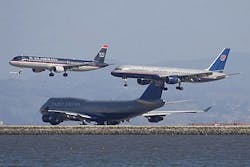FAA reaches out to industry for fresh technology ideas to prevent runway incursions
WASHINGTON, 25 July 2013. Researchers at the U.S. Federal Aviation Administration (FAA) in Washington are surveying industry to find companies with interest and expertise in technologies to help prevent runway incursion.
Runway incursions describe dangerous situations at airports where an unauthorized aircraft, vehicle, or person is on a runway and threatens collision with aircraft landing or taking off.
The FAA issued a presolicitation (solicitation number 14673) this week for the Runway Incursion Prevention project, which seeks to gather information to conduct possible future research dedicated to airport surface safety as U.S. commercial aviation shifts to the NextGen air traffic management system.
FAA officials caution that this presolicitation not yet a request for proposal (RFP); the nature of the competition has not been determined. FAA officials are considering a research project that will lead to recommendations for systems that warn aircraft pilots in real time of potential runway-incursions without intervention from air traffic control.
Runway incursion (RI) prevention is a longtime priority of the FAA and National Transportation Safety Board (NTSB), agency officials say. As early as 2000 the NTSB recommended a requirement for all airports with scheduled passenger service to install ground movement safety systems to prevent runway incursions.
These systems, NTSB said, should provide a direct warning capability to flight crews and demonstrate through computer simulations that the systems will, in fact, prevent these kinds of incidents.
Since then The FAA’s Runway Incursion Reduction Program (RIRP) has conducted many research programs and simulations that included several prototype systems to prevent runway incursions.
Most of these projects have involved airport surface surveillance to identify and warn of aircraft or surface vehicles in the wrong places; safety logic to evaluate the interaction between aircraft and vehicles operating at airports; and visual or audible warnings to warnings and vehicle drivers of a possible runway incursion, FAA officials explain.
FAA officials have tried, adopted, and rejected many runway-incursion warning systems that provide direct indications to the cockpit. These include surveillance such as the Airport Surface Detection Equipment-Model X (ASDE-X), induction loops embedded in the airport surface, Automatic dependent surveillance-broadcast (ADS-B) or a simple video camera.
Annunciation systems tried include relaying indication, alert, or warning of a runway incursion directly to the cockpit without interaction by air traffic controllers that involve visual cues on the airport surface.
Now the FAA wants to take runway-incursion technology to the next level, and officials are asking for industry recommendations to get there.
Any runway-incursion indications must be in real-time to be of any use to a pilot, aircrew, or ground vehicle operator. The time difference between a runway-incursion warning and a life-threatening incident could be a manner of only a few seconds, FAA officials point out. The FAA is interested in ideas from industry involving indication location, typic of indication information, and indication purpose.
Indication location involves indications that are located on the ground outside the cockpit, as well as inside the cockpit. Ground-based indicators, for example, include airport surface lighting and markings. Cockpit indicators, on the other hand, could include automated auditory alerts about runway conditions.
Type of indication involves information about rapidly changing airport elements like the locations of other aircraft or vehicles -- known as active indication, while information about static elements like runways or taxiway intersections is called passive indication.
Proposed indication solutions either should reduce preconditions for human errors or mitigate human error consequences. Systems architectures should integrate direct pilot indication purpose and types using ground-based and/or cockpit-based indication technologies. The goal is to provide several independent layers of protection against runway safety hazards.
Responses should spell out the concept, how it would reduce or eliminate runway-incursion, and how it would interface with other national airspace elements to include electronics, communications, lighting, and markings.
Any concept must address and describe the science, technology, or engineering behind their proposed system or procedures to provide direct runway-incursion indications. For example, does the proposal involve radar, cameras, acoustic sensing, or something similar?
Companies interested should email proposals no later than 23 Aug. 2013 to the FAA's Raymond Glembocki at [email protected]. Proposals also can be sent to Glembocki by post or by courier at Federal Aviation Administration, 800 Independence Ave. SW, Room 335, Washington, DC 20591.
For questions or concerns contact the FAA's Glembocki by email at [email protected], or by phone at 202-267-3692.
More information is online at https://www.fbo.gov/spg/DOT/FAA/HQ/14673/listing.html.
